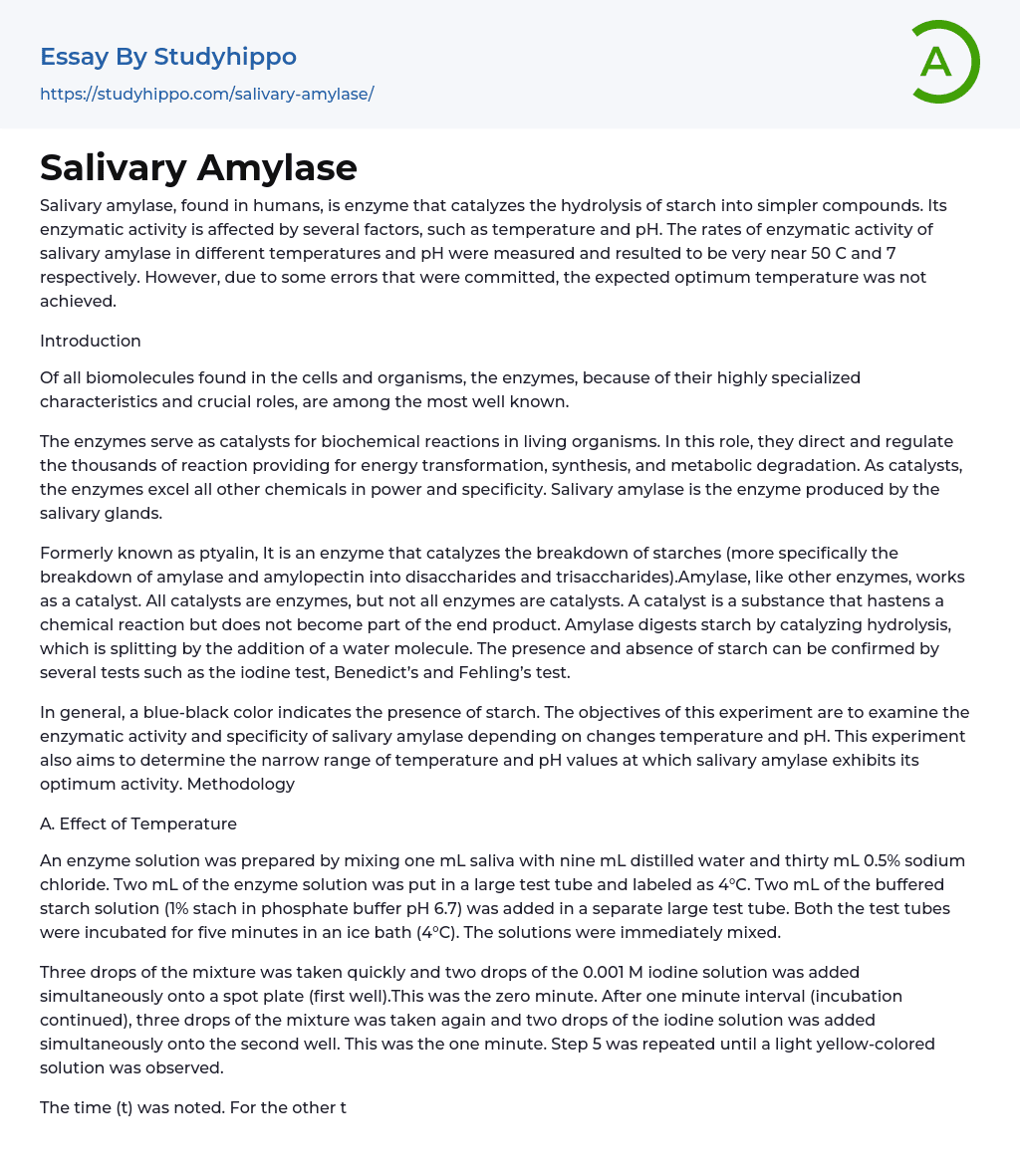Salivary amylase, found in humans, is enzyme that catalyzes the hydrolysis of starch into simpler compounds. Its enzymatic activity is affected by several factors, such as temperature and pH. The rates of enzymatic activity of salivary amylase in different temperatures and pH were measured and resulted to be very near 50 C and 7 respectively. However, due to some errors that were committed, the expected optimum temperature was not achieved.
Introduction
Of all biomolecules found in the cells and organisms, the enzymes, because of their highly specialized characteristics and crucial roles, are among the most well known.
The enzymes serve as catalysts for biochemical reactions in living organisms. In this role, they direct and regulate the thousands of reaction providing for energy transformation, synthesis, and metabolic degradation. As catalysts, the enzymes excel all other chemicals in power and sp
...ecificity. Salivary amylase is the enzyme produced by the salivary glands.
Formerly known as ptyalin, It is an enzyme that catalyzes the breakdown of starches (more specifically the breakdown of amylase and amylopectin into disaccharides and trisaccharides).Amylase, like other enzymes, works as a catalyst. All catalysts are enzymes, but not all enzymes are catalysts. A catalyst is a substance that hastens a chemical reaction but does not become part of the end product. Amylase digests starch by catalyzing hydrolysis, which is splitting by the addition of a water molecule. The presence and absence of starch can be confirmed by several tests such as the iodine test, Benedict’s and Fehling’s test.
In general, a blue-black color indicates the presence of starch. The objectives of this experiment are to examine the enzymatic activity and specificity of salivary amylase depending on changes temperature and pH
This experiment also aims to determine the narrow range of temperature and pH values at which salivary amylase exhibits its optimum activity. Methodology
A. Effect of Temperature
An enzyme solution was prepared by mixing one mL saliva with nine mL distilled water and thirty mL 0.5% sodium chloride. Two mL of the enzyme solution was put in a large test tube and labeled as 4°C. Two mL of the buffered starch solution (1% stach in phosphate buffer pH 6.7) was added in a separate large test tube. Both the test tubes were incubated for five minutes in an ice bath (4°C). The solutions were immediately mixed.
Three drops of the mixture was taken quickly and two drops of the 0.001 M iodine solution was added simultaneously onto a spot plate (first well).This was the zero minute. After one minute interval (incubation continued), three drops of the mixture was taken again and two drops of the iodine solution was added simultaneously onto the second well. This was the one minute. Step 5 was repeated until a light yellow-colored solution was observed.
The time (t) was noted. For the other temperatures (room temperature, 37, 50 & 70 °C), steps 1 to 6 were repeated following the desired incubation temperature. The reciprocal of time (1/time, min-1) in step 6 versus the temperature (T) was plotted. The optimum temperature of the amylase was determined.
B. Effect of pH
One mL of acetate buffer (pH 4) and one mL 2% unbuffered starch were mixed in a large test tube. Two mL of the enzyme solution was added in a separate large test tube. Both the test tubes were incubated for five minutes in a 37°C water
bath. The solutions were immediately mixed.
Three drops of the mixture was taken quickly and two drops of the 0.001 M iodine solution was added simultaneously onto a spot plate (first well).This was the zero minute. After one minute interval (incubation continued), three drops of the mixture was taken again and two drops of the iodine solution was added simultaneously onto the second well.
This was the one minute. Step 5 was repeated until a light yellow-colored solution was observed. The time (t) was noted. For the other pH (5, 6.7, 8 & 10), steps 1 to 6 were repeated using the appropriate buffer. Acetate buffer solution for pH 5, phosphate buffer solution for pH 6.7 and 8, and bicarbonate buffer for pH 10 were used. The reciprocal of time (1/time, min-1) in step 6 versus the buffer pH was plotted. The optimum pH of the amylase was determined.
- Organic Chemistry essays
- Acid essays
- Calcium essays
- Chemical Bond essays
- Chemical Reaction essays
- Chromatography essays
- Ethanol essays
- Hydrogen essays
- Periodic Table essays
- Titration essays
- Chemical reactions essays
- Osmosis essays
- Carbohydrate essays
- Carbon essays
- Ph essays
- Diffusion essays
- Copper essays
- Salt essays
- Concentration essays
- Sodium essays
- Distillation essays
- Amylase essays
- Magnesium essays
- Acid Rain essays
- Agriculture essays
- Albert einstein essays
- Animals essays
- Archaeology essays
- Bear essays
- Biology essays
- Birds essays
- Butterfly essays
- Cat essays
- Charles Darwin essays
- Chemistry essays
- Dinosaur essays
- Discovery essays
- Dolphin essays
- Elephant essays
- Eli Whitney essays
- Environmental Science essays
- Evolution essays
- Fish essays
- Genetics essays
- Horse essays
- Human Evolution essays
- Isaac Newton essays
- Journal essays
- Linguistics essays
- Lion essays




